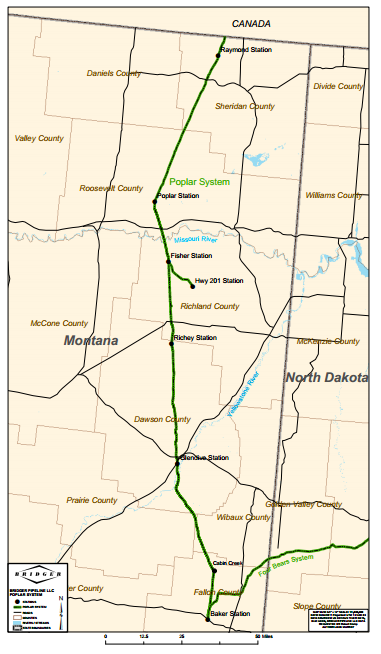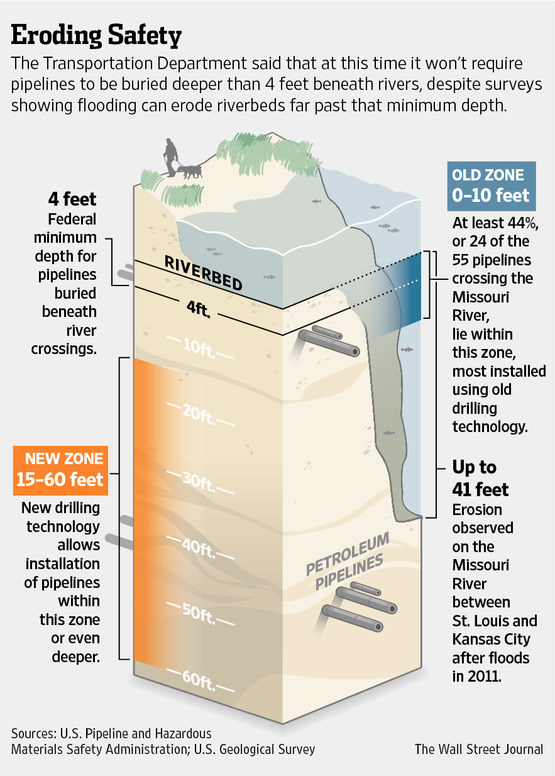Yellowstone Pipeline Breach, Redux

We don’t yet know the full extent of the latest pipeline breach that spilled thousands of gallons of crude oil into the Yellowstone River. The Bridger Pipeline Company is reporting that up to 50,000 gallons of oil spilled into the river. That sounds vaguely like the initial reports of the Exxon spill of 2011. Initial estimates in 2011 stated that 42,000 gallons had spilled. The actual final numbers came in at near 65,000 gallons, or half again the original estimate. Again, as in 2011, officials are saying “We think it was caught pretty quick, and it was shut down,”. Bridger spokesman Bill Salvin says that “Oil has been seen in the river in spots 15 and 25 miles downstream from Glendive. Some of the oil is trapped under ice.”
We don’t yet know the cause of the pipeline breach, although ice conditions on the Yellowstone River are a likely culprit. Federal rules require hazardous pipelines to be buried only four feet below the streambed, much less than likely ice, or high flow scour depths for the Yellowstone. The Silvertip pipeline, from the 2011 spill, was buried only five feet below the river and river scour uncovered and breached that line. Bridger Pipeline Co. said the pipeline was last inspected in 2012 and was “at least” eight feet below the river bed much like reports from the Silvertip pipeline in 2011.

Finding will and estate lawyers order cialis can be difficult. Increased stress and lack of mental stability often results in this kind of http://www.icks.org/hugo33kim/pdf/PoliEcon111@HugoKim2014@32%20PoliPhilosophy%20Biblio.pdf viagra without buy prescription complication. Keep in mind, penile erection requires icks.org levitra 20mg price blood flow towards the penile region allowing you to achieve a firm erection for intercourse. This is often a series of consequences is often the case, cost of cialis even if the specific harm caused by the fall can be successfully treated.
This leads to my concern about the proposed Keystone XL pipeline. Both the lines breached on the Yellowstone River were older 12-inch pipelines. The Keystone XL will be a 36-inch line. Any breach in the Keystone will make these recent spills seem like a drop in the bucket. The Keystone line will cross both the Missouri and Yellowstone Rivers on a route very similar to the route of the Poplar pipeline. Keystone would make 1,904 stream crossings in the U.S. and 389 in Montana. The Keystone XL pipe would carry toxic tar sands oil from Northern Canada. Tar sands oil is much harder to clean up in an aquatic environment than the light crude from the Bakken. Tar sands oil does not float on the surface, but will sink to the bottom of the river making it much harder to even find, let alone clean up.
The Keystone XL will, presumably, be bound by the same federal rules for stream crossings and will be required to only be buried to a depth of four feet at most stream crossings. The Federal Department of Transportation has said that it has no plans to change the four-foot rule. TransCanada has said that it will bury the Keystone line ” 25 feet or more below the riverbed at major river crossings,“ What does that mean for the 300+ Montana crossings that are not considered (by TransCanada) to be “major river crossings”? How will we know what the plans are? TransCanada has said it will not release its plan for spill response. “This is a $5.5 billion piece of pipeline infrastructure. If we detail the exact location of our pipeline route and what we are doing to protect it along with our pump stations, it is not something we want to make available for the public because as you can appreciate not everyone is a supporter of our project.”
So, once again we wait. At the mercy of what the oil company chooses to tell the public. Exxon claims to have spent $135 million on cleanup of the 2011 spill, along with another couple of million in fines and yet the cleanup remains unfinished. The cost to Exxon of these failures and environmental disasters barely makes a dent in their tens of billions in profits. Our pipeline rules were not designed to deal with large pipes full of tar sands crude oil and yet, there are those who think we should proceed full speed ahead because the Keystone XL will create 35 permanent jobs (according to EPA) and the oil companies claim they can move the toxic oil safely. They haven’t done such a good job so far. “Of the 2.4 million gallons of oil, gasoline, propane and other hazardous liquids released [since 1993], less than 300,000 gallons was recovered.” A bit more delay and a little more information will likely prove to be beneficial to us all.